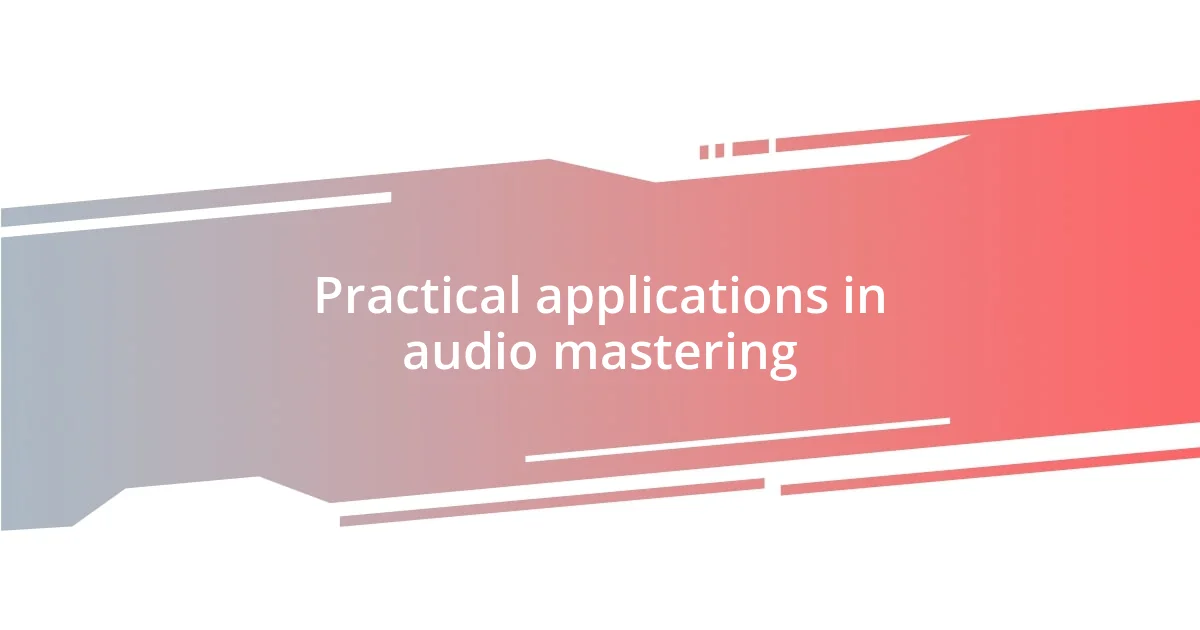Key takeaways:
- Dynamic range management is essential in both audio and photography to ensure clarity and emotional resonance, allowing all elements to be heard and seen effectively.
- Key techniques for effective dynamic range management include compression, equalization, and thoughtful level adjustments, which help maintain consistency and clarity.
- Using tools such as limiters, HDR imaging, and immersive sound environments can significantly enhance dynamic range, creating rich and engaging experiences for the audience.

Understanding dynamic range management
Dynamic range management is crucial in various fields, particularly in audio and photography. I remember the first time I recorded a band and realized just how important it was to control the dynamic range. The loud guitar riffs clashed with the soft vocals, distracting the listener completely. Have you ever found yourself straining to hear the lyrics over an overwhelming instrumental? That’s the struggle of poor dynamic range management at work.
In essence, dynamic range refers to the difference between the softest and loudest sounds or light levels in a given medium. Balancing these elements ensures that all aspects are audible and visually coherent. I once spent hours adjusting levels after realizing that some of my favorite moments were buried under a wall of sound. It taught me that effective dynamic range management isn’t merely a technical process; it’s about emotional expression and clarity.
Understanding and applying dynamic range management techniques can transform your work, allowing the audience to experience the intended emotions and nuances fully. Have you ever viewed a photograph that tugged at your heartstrings because of its perfect light balance? That’s the power of managing dynamic range effectively. It’s a delicate dance between contrasts, making every component of your creation resonate with the audience.

Importance of dynamic range control
Dynamic range control is vital because it shapes the audience’s experience. I recall shooting a sunset where the colors were breathtaking, but the shadows hid much of the beauty. Without proper dynamic range management, those moments can easily fade into obscurity, leaving an incomplete impression that lacks emotional depth.
In audio, it’s even more pronounced—for instance, imagine listening to one of your favorite songs only to find the vocals lost amid overpowering instrumentals. That can be disheartening! I’ve learned that thoughtful dynamic range control allows every element to shine, creating a richer listening experience. This balance can transform an ordinary sound into a captivating one.
As I continue to develop my dynamic range skills, I’ve gained a deeper appreciation for how it influences storytelling in both audio and visual media. It’s not just about technical proficiency; it’s about ensuring every whisper and shout serves the narrative. Have you considered how impactful it feels to truly hear every note in a song or see every detail in an image? That’s the beauty of effective dynamic range control.
| Dynamic Range Control in Audio | Dynamic Range Control in Photography |
|---|---|
| Ensures clarity of vocals amidst instruments | Enhances visibility in well-lit and dark areas |
| Transforms chaotic mixes to harmonious sounds | Creates emotional resonance through light balance |

Techniques for effective range management
When it comes to managing dynamic range effectively, I’ve discovered that a few key techniques can make a significant difference. One of my favorites is the use of compression, which helps level out sounds by reducing the volume of the louder parts. There was a time I recorded a voiceover that was passionate yet fluctuated wildly in volume. By applying compression, I made it much more consistent, allowing the listener to focus on the message rather than the variations in sound. This technique helps to maintain clarity, ensuring that no important details get lost.
- Use Compression: Controls the volume levels for consistency.
- Employ EQ (Equalization): Cuts through muddiness, enhancing clarity.
- Adjust Levels Thoughtfully: Balance all elements for optimal presentation.
Another technique I find invaluable is dynamic automation in mixing. During one of my projects, I automated the volume levels of a piano track to seamlessly blend with a vocal line. It felt like a beautiful dance—the piano gently guiding the listener’s emotions while the vocals took center stage. This kind of attention to dynamic shifts not only enriches the audio experience but also creates an emotional journey for the audience. Implementing these techniques fosters a captivating narrative that resonates well beyond the initial listen.

Tools for dynamic range enhancement
One of the tools I often turn to for dynamic range enhancement is a quality limiter. I remember a project where I was tasked with mastering a thrilling action scene. I needed to ensure that the explosive sound effects didn’t drown out the dialogue. Applying a limiter allowed me to cap those extreme volumes while still retaining the punchy impact of the effects. It’s amazing how this simple tool can make such a difference in ensuring that every sound contributes to the story without overwhelming the listener.
Another essential tool I find helpful is the use of HDR imaging in photography. There was a moment during a landscape shoot where the sky was breathtaking, but the foreground was too dark. By capturing multiple exposures and merging them, I managed to bring out the hidden details in both the highlights and shadows. Have you ever seen a photograph that just pulls you in because you can see every element clearly? That’s the magic of HDR— it allows for a more vivid storytelling experience by balancing the dynamic range beautifully.
Lastly, I can’t emphasize enough the value of immersive sound environments when enhancing dynamic range. Using 3D audio tools in my latest project transformed how the audience engaged with the soundscape. I recall placing ambient sounds strategically so they felt like they were enveloping the listener. The result? A richer, more engaging experience that propelled the story forward. Isn’t it incredible how the right tools can turn ordinary moments into extraordinary experiences?

Practical applications in audio mastering
In audio mastering, I often find myself relying on subtle tweaks that can have a substantial impact. For instance, during a recent project, I was mastering a jazz track where the solo trumpet needed to soar above the ensemble without losing its natural warmth. I carefully applied a touch of gentle limiting on the trumpet, which allowed it to punch through the mix while still preserving its rich tonal quality. Doesn’t it feel satisfying when a simple adjustment makes such a noticeable difference?
Another essential aspect of mastering lies in the careful adjustment of stereo width. I recall working on an indie rock album where the guitars felt constrained in a narrow soundstage. By strategically using stereo expansion tools, I was able to give the guitars a more spacious presence, creating a sound that enveloped listeners. It’s fascinating how widening the sound can transform the emotional weight of the music. Have you experienced that feeling of being physically surrounded by sound? It’s nothing short of exhilarating.
Finally, I can’t forget about the critical role that reference tracks play in my mastering process. Having a few well-chosen tracks by my side helps me maintain the desired dynamic range and sonic characteristics. I remember mastering a ballad and constantly referring to a well-loved classic. This practice provided clarity and kept my decisions in check, particularly when it came to balancing dynamics. Wouldn’t you agree that having a sonic benchmark can be immensely helpful in shaping the final product?

Tips for optimizing dynamic range
When optimizing dynamic range, one of my go-to strategies is the use of automation during mixing. I recall a time while mixing a soulful ballad where the vocalist’s softer phrases tended to get lost among the accompanying instruments. By automating the levels, I was able to gently elevate those quieter moments without sacrificing the overall balance. Have you ever wondered how a little adjustment can create such a profound emotional effect? It’s all about making sure every nuance shines.
Another tip I find invaluable is monitoring your work in different sound environments. I have a habit of playing back my mixes in my car, which has a completely different acoustic character compared to my studio. One day, while driving, I noticed that certain elements of the mix became muddled in the car’s bass-heavy system. It made me rethink my approach to dynamic range. Don’t you think it’s fascinating how different listening contexts can unveil hidden flaws in your work?
Lastly, I prioritize the careful selection of instruments and their dynamic capabilities. I remember working on an orchestral piece where the strings and brass had to interplay delicately. I chose instruments with a wider dynamic range, allowing for powerful crescendos and soft, intimate moments. This choice not only added depth but also created an emotional journey throughout the track. Have you ever considered how instrument selection can shape the listener’s experience? It’s something that often unfolds a whole new layer of storytelling in music.















